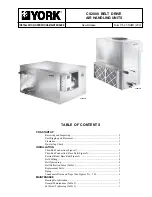
Page 7
TAA SERIES
Requirements
These instructions are intended as a general guide and do
not supersede local or national codes in any way. Consult
authorities having jurisdiction before installation.
In addition to conforming to manufacturer’s installation
instructions and local municipal building codes, installation
of Lennox air handler units (with or without optional electric
heat), shall conform with the following National Fire
Protection Association (NFPA) standards:
S
NFPA No. 90A Standard for Installation of Air
Conditioning and Ventilation Systems
S
NFPA No. 90B Standard for Installation of
Residence Type Warm Air Heating and Air
Conditioning Systems
This unit is approved for installation clearance to
combustible material as stated on the unit rating plate.
Accessibility and service clearances must take
precedence over combustible material clearances.
Refrigerant Piping Connections
TAA series evaporator coils have a holding charge of
nitrogen
or dry air. If there is no pressure when the rubber
plugs are removed, check the coil for leaks before
installing. After installation, pull a vacuum on the coil and
line set before releasing the outdoor unit charge into the
system.
Table 1. TAA Series Refrigerant Connections
Size/Quantity
Models
Liquid Line
Vapor/ Suction Line
−072S4S
5/8" (1)
1−1/8" (1)
−090S4D, −120S4D,
and −150S4D
5/8" (2)
7/8 (2)
−180S4D, and
−240S4D
5/8" (2)
1−1/8" (2)
For single−stage applications, pipe the upper and lower
evaporator circuits together (does not apply to TAA072).
For two−stage applications, pipe the stage 1 system to the
lower part of the evaporator and the stage 2 system to the
upper part of the evaporator. Table 1 lists piping connection
sizes at the evaporator coil. The line set between the TAA
air handler and outdoor unit should be sized per the
Lennox Refrigerant Piping Guidelines.
4. Route piping through either side of the unit.
5. Remove the knockouts from the piping mullion. Install
the rubber grommets into the piping holes.
6. Remove the plugs from the vapor and liquid line stubs.
7. Wrap a wet rag around each TXV before brazing to
avoid overheating the valve.
8. Remove protective coil cover between TXVs and
evaporator coil as illustrated in figure 1.
REMOVE TAPES
PROTECTIVE COIL COVER BETWEEN TXV(S)
AND EVAPORATOR COIL.
PROTECTIVE COIL COVER BETWEEN TXV(S)
AND EVAPORATOR COIL MUST BE REMOVED
BEFORE UNIT START−UP.
Figure 1. Protective Coil Cover Removal
























